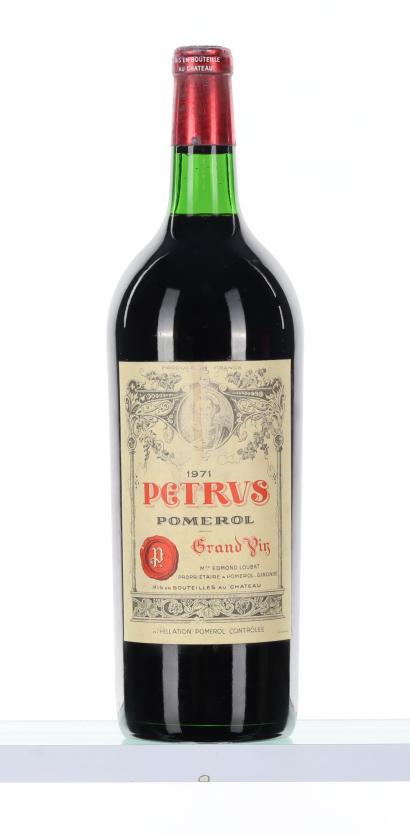Given the celebrity of Pétrus today it seems almost inexplicable that the property did not appear in Bordeaux’s famous 1855 Classification. In truth no Pomerol wine was considered, nor any from neighbouring Saint-Emilion. 150 years ago these Right-Bank communes were deemed almost country wine producers, lacking the prestige, the nobility and possibly the marketing nous of their Left-Bank counterparts. The only châteaux of note in the entire Libournais district were in the commune of Fronsac, and even these were disregarded.

It wasn’t until after 1945 that Pomerol developed an international following, this largely on account of the work of one man, Libourne wine merchant Jean-Pierre Moueix. Moueix built a clientèle for the wines of his region in Northern France and Belgium, clients who were rewarded with allocations of Pétrus, which had been distributed by Moueix since 1945. The then owner, hotelier Madame Loubat, also tasked Moueix with supervising the winemaking under a plan to place Pétrus at the pinnacle of Pomerol and equal in stature to the First Growths of the Left Bank.
While not quite attaining royal patronage, Madame Loubat achieved some publicity when she sent two magnums of her 1938 vintage as a gift for the wedding of Princess Elizabeth and Philip Mountbatten in 1947. Pétrus also received a surprise boost in the US in the early 60s when stories spread that it was President Kennedy’s preferred wine.
The négociant bought a share in the property in 1964, his eldest son Jean-François acquiring the remainder in 1969. A year later Moueix enlarged the original 7 hectares of vines with the purchase of a further 4.4 hectares from neighbour Chateau Gazin.
Jean-Pierre’s second son Christian Moueix joined the company in 1970 and assumed responsibility for Pétrus until 2009, when his elder brother Jean-François, who had formally inherited the entirety of the property in 2003, took over its management. Distribution of the wine, which had for decades been in the hands of Établissements Jean-Pierre Moueix (with Christian Moueix as President since 1991), was ceded to its new owner’s company, Groupe Duclot, in 2014 via a subsidiary Clés Distribution. Up to that point, merchants visiting Moueix’s offices in Libourne for the annual en primeur campaign were rewarded with a small sample of the latest vintage of Pétrus alongside other wines owned by J-P Moueix including Lafleur-Pétrus, Latour à Pomerol and Trotanoy. Spitting out a tasting sample of Pétrus was one of the iconic moments in any wine professional’s career.
Pétrus is sited on the eastern flank of the Pomerol plateau, Saint-Emilion’s landmark church spire easily visible. The vineyard, a single entity on ancient iron-rich blue clay, is unmissable, rising above the surrounding vines. The combination of sun exposure and drainage is a major element in the wine’s singularity, as is its (since 2010) 100% reliance on the merlot grape. The site is not perfect however: a helicopter was called in to blow-dry grapes ahead of the 1987 harvest; the vineyard was carpeted with plastic sheets to prevent heavy rains saturating the soil in 1992; and frost prevention measures are required in some years.
There are great years for Pétrus – 1945 is at the pinnacle, with 1964, 1982,1989, 1990, 1995, 1998, 2009, 2010, 2016 all highly regarded. Second tier vintages include 1983, 1988, 1994 and 1997. No Pétrus was bottled in the difficult years of 1991 and 1965. There is no second label: vats not selected for Pétrus are sold discreetly in bulk, surfacing elsewhere in unconnected bottles of Pomerol.
With an annual production of around 30,000 bottles, demand for Pétrus always exceeds supply, even given its stiff opening price. 2020 Petrus was launched in the (UK) market in June 2021 at £1900 per bottle yet was trading at £3800 before the end of the year. Large formats of Pétrus have been an auction staple for many years, fetching a multiple of two or three times the pro-rata bottle price. Large formats have also been victim to counterfeiting on account of the value premium.
Classic mature vintages of Pétrus have also fallen prey to fraudsters. It is reported that Hardy Rodenstock bottles claimed to be from the celebrated 1929 and 1921 vintages were presented to a number of leading journalists in 1995 by Rodenstock, all of whom were surprised at how young they was showing. Robert Parker published a note on the 1929 (“It could have easily been mistaken for a 30-35 year old wine”) before they were subsequently called out as a fake: a note that still circulates in the ether, causing owners of the real-deal 1929 to be somewhat perturbed at its maturity.
Wine appraisers are well-armed with tools to recognise fakes today however, and unlike some producers Pétrus is prepared to comment on authenticity of rare bottles at the request of authorised distributors. Since 2017 the château ceased releasing double-magnums and above in order to widen availability of 75cls.
The name Bérrouet has long been associated with Pétrus. In 1964 Jean-Pierre Moueix appointed the then 22-year-old Jean-Claude Bérrouet as ‘winemaker’ at the property after, it is said, a series of monthly meetings where the two discussed the arts and the economy as well as wine. Bérrouet served for 44 years, rising to the job of Technical Director. In 2008, in the tradition of Bordeaux, he was succeeded as winemaker by his son Olivier.
The taste of Pétrus is indelibly associated with its unique soil, its now total reliance on old vine merlot, and on the guiding hand of Bérrouet, whose objective is to make wines that are “delicate, elegant and harmonious”. The wine is normally medium bodied yet rich with a delineated structure and a complex suite of flavours, flavours that give great scope for the descriptive talents of critics. Forceful yet effortless perhaps. Unlike many pure merlots it takes time to get into its stride and in top years lasts multiple decades.
Enquire here about Provinance's availability of wines from this producer.
